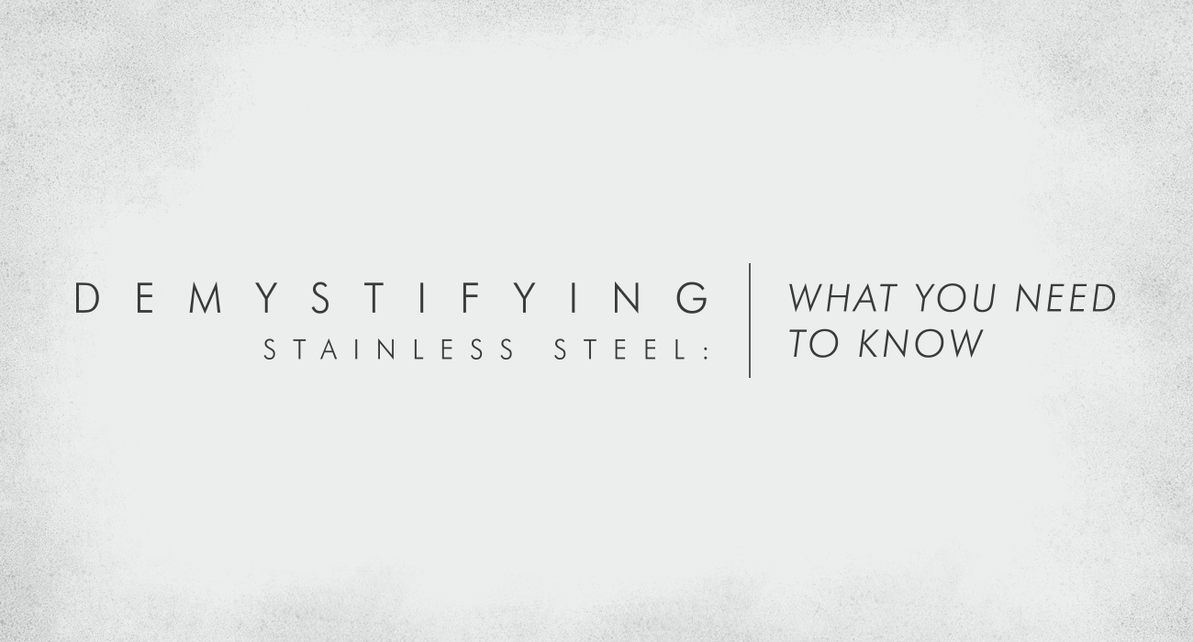Demystifying Stainless Steel: What You Need to Know
Have you ever noticed that some stainless steel is more durable than others? Turns out, stainless steel is a broader concept than many realize. Why should you know about stainless steel though? Being properly aware of what you’re investing your money into is important. We don’t want you to buy a product which is insufficient for your needs, nor do we want you to spend money on a piece of equipment which provides more protection than you really need...
Have you ever noticed that some stainless steel is more durable than others? Ever wondered why some is magnetic and some is not? Turns out, stainless steel is a broader concept than many realize, referring simply to a group of hybrid metals (a.k.a. "alloys"). Why should you know about stainless steel though?
Being properly aware of what you’re investing your money into is important. We don’t want you to buy a product which is insufficient for your needs, nor do we want you to spend money on a piece of equipment which provides more protection than you really need.

So, let’s talk stainless steel. Stainless steel alloys are made by mixing iron with at least 10.5% chromium, as well as other metals and materials like carbon. The different "recipes" for stainless steel result in different types, impacting price, strength, and corrosion resistance. You may have noticed tables marked "430 Series". That notation tells you something about its composition. It's part of a larger group called "ferritic" stainless steel.
Another group common in foodservice (and elsewhere) is called "austenitic." Most commercial sinks are made from a type of austenitic steel tagged "304 Series."
All of this can get rather confusing, so we’re here to break it up a bit for you.
Austenitic Steel
The most common type of steel used today, austenitic steel accounts for 70% of steel production. Because of the materials used in this alloy, it’s particularly resistant to corrosion.
304 Austenitic Stainless Steel
Known for being the most common type of stainless steel used, 304 is practical and hardy. It’s resistant to food products, sterilizing solutions, and most organic materials. Because of its superior rust protection, it’s used in sink bowls and other surfaces which are most likely to come in contact with corrosive substances. Unfortunately, due to the high cost of nickel and how difficult it is to work with austenitic steel, this is more expensive than many other stainless steel options.
201 Austenitic Stainless Steel
You could consider 201 the kid brother of 304, since they share a similar chemical composition. It’s still food safe, but doesn’t hold up to corrosion quite as well, so it’s not going to withstand chemicals like bleach. Because of this, it tends to be less expensive. You’ll often find it in the form of handwashing sinks.
Ferritic Steel
The main way ferritic steel differs from austenitic is that is contains nickel and is also magnetic. For example, want to find out if your stainless steel is austenitic or ferritic? Grab yourself a magnet. If it sticks, it’s ferritic. It’s known for being both corrosion resistant and hold up against stress.
430 Ferritic Stainless Steel
For environments with less chemical use, 430 is a great option, as it’s made with chromium. 430 is used most often for ovens, refrigerators, and economic cost sinks or tables. While it may be cheaper, if properly taken care of, it can last you a long time and will end up being a wise investment.
316 Ferritic Stainless Steel
 316 isn’t something you’ll find very often in the restaurant world,
though it’s been known to pop up occasionally, like in food trolleys meant
for hospitals or food processing equipment. It’s extremely
corrosion-resistant because it has larger quantities of nickel, and as
such, it is mainly used in the medical world. Because of the amount of
nickel it contains, it’s difficult to fabricate, and so is quite
expensive.
316 isn’t something you’ll find very often in the restaurant world,
though it’s been known to pop up occasionally, like in food trolleys meant
for hospitals or food processing equipment. It’s extremely
corrosion-resistant because it has larger quantities of nickel, and as
such, it is mainly used in the medical world. Because of the amount of
nickel it contains, it’s difficult to fabricate, and so is quite
expensive.
Gauge
Counter-intuitively, the lower number gauge, the thicker the steel. Take note that while the steel may have a lower gauge, and therefore be thicker, the type of steel still matters. Gauge is just the density, not the quality.
18-Gauge
Also known as the economy gauge, for a lower cost you get a respectable piece of stainless steel. It tends to work best for things like sandwich or salad prep tables. (1.24mm)
16-Gauge
This is where you get the most bang for your buck. It’s a quality thickness which will serve many uses, but won’t break your budget. You’ll find plenty of well-built sinks and prep tables which use 16-gauge. (1.65mm)
14-Gauge
The perfect gauge for butchers. You can hammer and hack things on this gauge all day long without bowing the stainless steel. It’s also going to look smooth and sleek over a longer period of time. (2.11mm)



